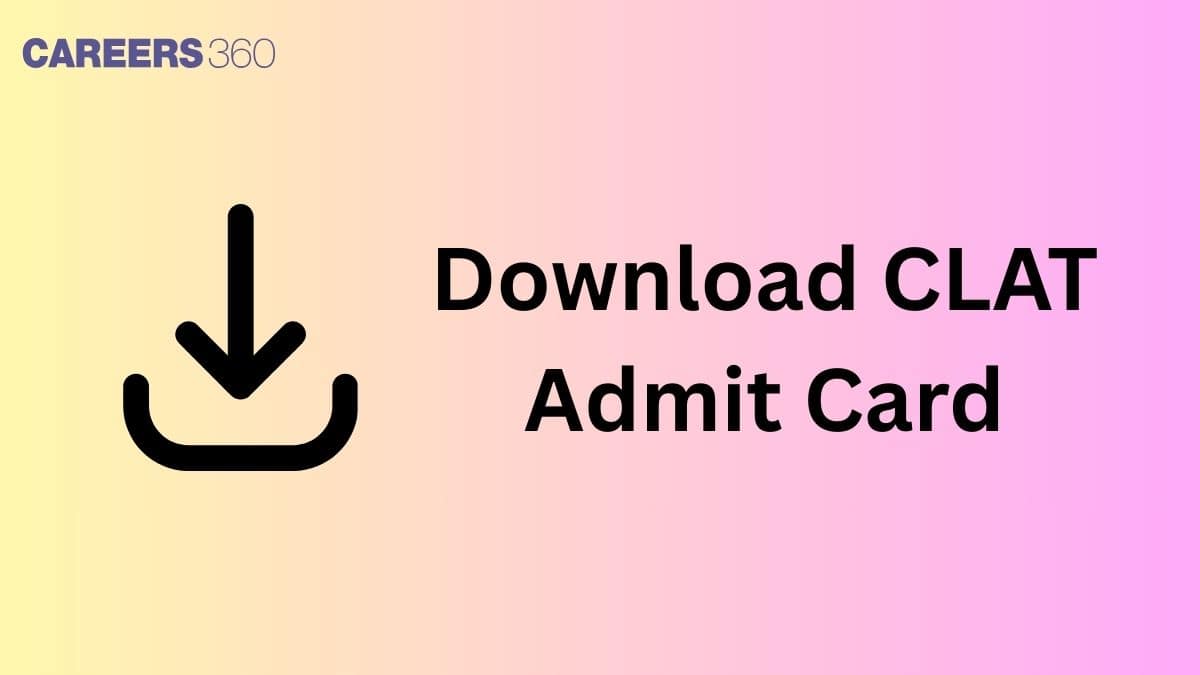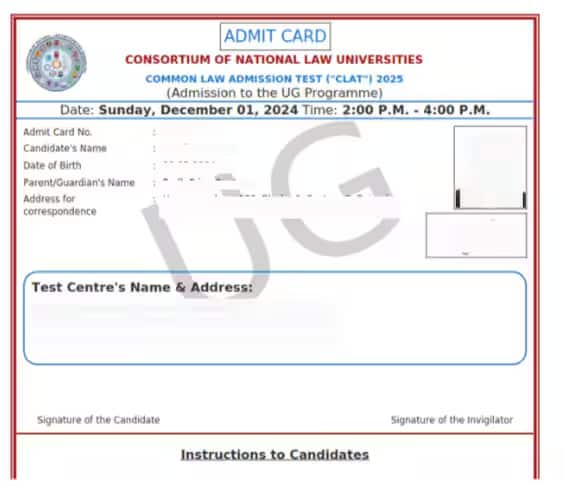Amity University-Noida Law Admissions 2026
Among top 100 Universities Globally in the Times Higher Education (THE) Interdisciplinary Science Rankings 2026
The Consortium of National Law Universities has issued the CLAT admit card 2026 on November 22, 2025. It has been a trend that the CLAT admit cards are released around 15 days from the date of the exam. The admit card of CLAT 2026 is available for download until half an hour before the start of the exam i.e. 1:30 pm on December 7, 2025. Candidates who have completed CLAT 2026 registration will be able to download the CLAT admit card 2026 from the official website at consortiumofnlus.ac.in through their login using their registered mobile number and password. The consortium will conduct CLAT 2026 on December 7, 2025, in offline mode at around 131 CLAT exam centres all over India.
This Story also Contains

Candidates are required to carry a printout of the CLAT 2026 admit card on the exam day. It is advised to keep the admit card of CLAT 2026 preserved by the candidate till the end of the NLU admissions process. The admit card of CLAT 2026 mentions important details like the allotted CLAT exam centre, date and time of exam, reporting time and the CLAT 2026 exam instructions. Through the Common Law Admission Test, candidates will be admitted into the 5-year LLB and LLM programmes of participating NLUs. Read on to get all details about CLAT admit card 2026 including steps to download, exam instructions and more.
Given below are the important dates for CLAT admit card 2026.
| Event | Date |
|---|---|
| CLAT 2026 application form release date | August 1, 2025 |
Last date to apply for CLAT 2026 | October 31, 2025 |
| Application correction window | To be notified |
CLAT admit card 2026 release date | November 22, 2025 |
| Deadline to download the CLAT admit card 2026 | December 7, 2025 up to 1:30 PM |
December 7, 2025 |
Candidates can download the CLAT admit card 2026 by following the below steps:
Log on to the official website of CLAT 2026 at consortiumofnlus.ac.in.
Click on the “CLAT 2026” tab.
Navigate to the CLAT 2026 candidate login portal.
Log in using your mobile number and password.
Click on the “Download admit card” link.
The CLAT admit card 2026 will appear on the screen.
Check all the details given on the admit card carefully.
Download and take a print out of the CLAT admit card for future use.
Among top 100 Universities Globally in the Times Higher Education (THE) Interdisciplinary Science Rankings 2026
Ranked #18 amongst Institutions in India by NIRF | Ranked #1 in India for Academic Reputation by QS Rankings | 16 LPA Highest CTC
Name of the candidate
Roll number and application number
Exam centre name, and address
Exam timings along with reporting time
Instructions for appearing in the exam

In case candidates spot a discrepancy in their CLAT 2026 hall ticket, they can get it rectified by the concerned authorities. Candidates should immediately contact the CLAT 2026 Helpdesk. The discrepancy in details like name, date of birth, photograph etc can be rectified through the CLAT Helpdesk. The details of the CLAT 2026 helpdesk have been given in the table below:
| Particulars | Details |
|---|---|
clat@consortiumofnlus.ac.in | |
Contact number | 080 47162020 (10:00 am to 05:00 pm on all working days) |
The login password is needed to download the CLAT 2026 admit card. In case it is forgotten, candidates can retrieve the CLAT 2026 login password by using the forgot password option. The consortium will send an OTP on the registered mobile number to reset the login password.
The CLAT 2026 exam will be held in offline mode.
Indian Nationals/ NRIs are eligible to get admission through CLAT 2026.
Foreign nationals are not required to appear for an entrance exam.
A total of 24 NLUs will participate in the CLAT 2026 admission process.
Once the CLAT 2026 application form is filled, no changes can be made in the category, the programme cannot be changed.
The CLAT 2024 application fee is non-refundable.
You may also check:
The Consortium of NLUs does not issue any physical copies of the admit card. Candidates can download the CLAT admit card 2026 through their login. After downloading, candidates must take a printout of the admit card to the exam hall. If the photograph printed on the CLAT admit card 2026 is unclear, candidates must affix a photograph on the admit card.
Here are the exam day instructions of CLAT 2026 that will also be given on the admit cards:
Candidates will be allowed to enter the exam centre premises from 1 pm onwards, the exam starts at 2 pm.
Once a candidate has entered the exam hall/classroom, they will not be permitted to leave until 4 pm.
No candidate will be allowed to enter the exam centres after 2:15 pm.
Candidates will not be allowed to use the washroom during the test.
No clarification regarding the question booklet can be sought during the examination.
If candidates find any discrepancy or unsealed question booklet, they can request the invigilator to change the booklet.
Candidates must enter the QB Number and the OMR Response Sheet Number and sign in the space/column in the attendance sheet.
Candidates can take the Question Booklet and signed admit card after the conclusion of the exam.
Also, check - CLAT Syllabus 2026
The following documents will be accepted as ID proof on the day of CLAT 2026 exam:
Aadhaar Card (Should be updated with a contemporary photo.)
Passport
PAN Card
Ration Card / PDS Photo Card
Voter ID Card
Driving Licence
Also, check - CLAT Previous Year Question Papers
The bell timings of CLAT 2026 describe the step-by-step schedule for conduct of CLAT on the exam day. It covers the time from when the exam starts till it ends. The bell timings provide the time for activities such as entry of the candidates, last time to enter the exam hall, commencing of the exam and other details. The full schedule is given in the table below.
| Time | Type of Bell | Purpose |
|---|---|---|
1:00 P.M. | Long Bell | Permitting the entry of candidates inside the test centre premises |
1:30 P.M. | Long Bell | Permitting the entry of Candidates inside the hall/ classroom |
1:50 P.M. | Short Bell | - Distribution of the sealed Envelopes - Announcement of Instructions by the Invigilators |
2:00 P.M. | Long Bell | Commencement of the test. The candidates can open the sealed envelopes |
2:15 P.M. | Short Bell | No candidate will be allowed to enter the test centre after this time |
3:00 P.M. | Short Bell | Marks the completion of 60 (sixty) minutes of the test |
3:50 P.M. | Short Bell | Warning Bell to indicate that 10 (ten) minutes are remaining for the test to end |
4:00 P.M. | Long Bell | Marks the Completion of the test. No candidate will be allowed to write anything on the OMR Response Sheet/Question Booklet after this Bell |
You may also check:
Candidates must carry the following items to their designated examination centres.
CLAT admit card 2026
An analogue watch
A valid ID card such as an Aadhar card, voter ID, passport, PAN card
A blue and black pen
A transparent water bottle (Optional)
Any study material like handwritten notes etc.
Mobile phones
Smartwatches
Calculators
Any food items
Also, check - CLAT Mock Test 2026
Downloading the CLAT 2026 admit card is the last step before candidates appear for the exam. Given below are some of the last-minute preparation tips for CLAT 2026:
Given below are a few important points regarding the CLAT admit card 2026:
The allotted exam centre is mentioned on the CLAT 2026 hall ticket. Candidates must arrive at the CLAT 2026 exam centre at the prescribed reporting time. The exam will be conducted at around 131 CLAT test centres across the country. Students are allowed to enter three exam centre choices in the order of preference at the time of registration. Candidates will also given the facility to make changes in their CLAT test centres 2026 through correction window, through their login. The complete list of CLAT exam centres is given below:
Agra | Gandhinagar | Kolkata | Ahmedabad |
Allahabad | Gangtok | Kota | Amritsar |
Aurangabad | Ghaziabad | Kurukshetra | Barrackpore |
Barasat | Gorakhpur | Lucknow | Madurai |
Gurugram | Greater Noida /Noida | Mohali | Mumbai |
Haldwani | Guwahati | Muzaffarpur | Mysore |
Bangalore | Bhopal | Hisar | Nagpur |
Bilaspur | Hyderabad | Imphal | Varanashi |
Indore | Jabalpur | New Delhi | Navi Mumbai |
Bhubaneswar | Calicut | Jaipur | Patiala |
Chandigarh | Jalandhar | Patna | Coimbatore |
Chennai | Jammu | Pune | Durg |
Dehradun | Jamshedpur | Raipur | Shimla |
Ernakulum | Jodhpur | Ranchi | Tiruchirappalli |
Faridabad | Kanpur | Shillong | Srinagar |
Siliguri | Thane | Rajahmundry | Salem |
Sonepat | Thiruvananthapuram | Puducherry | Kanyakumari |
Visakhapatnam | Vijayawada | Chittor/Tirupathi | Kottayam |
Amrawati (Maharashtra) | Hooghly | Kurnool | Tirunelveli |
Cuttack | Hubli / Dharwad | Vellore | Gwalior |
Vadodara | Surat | Meerut | Mangalore |
Rajkot | Diu | Silvassa |
You may also check:
Frequently Asked Questions (FAQs)
Yes, the CLAT 2026 hall ticket is released on November 22, 2025.
Candidates can download their CLAT admit card 2026 from the official website: consortiumofnlus.ac.in through their login.
Yes, the CLAT 2026 exam will be conducted offline through pen and paper based test mode.
The consortium of NLUs sets the CLAT question paper.
On Question asked by student community
Hello,
Yes, with an AIR of 415 in the SC category and scoring around 67 marks, you have a strong possibility of getting admission into Chanakya National Law University, Patna, especially in later counselling rounds, as your rank falls within the typical range for SC candidates in Tier 2 NLUs.
HELLO,
For CLAT 2026 counselling , the only official registration window announced by the Consortium of NLUs was from 17 Dec 2025 to 27 Dec 2025 that was last date to register and pay the fee. There are no additional or alternate registration dates released for 2026 beyond this window.
With an AIR of 34724 and OBC category rank of 7153, chances of getting a seat in DSNLU Visakhapatnam are low in early rounds. However, since you are already invited for counselling, there may be some chance in later rounds depending on seat vacancy and cut-off movement. You should participate
With a CLAT LLM rank of 13656, getting a top NLU is difficult. You may have chances in lower-ranked NLUs or private law universities, depending on seat availability and category.
You can check CLAT LLM counselling details here:
https://law.careers360.com/articles/clat-llm-cut-off
Hello there,
Having a 15000 general rank and 1740 as your SC category rank, your chances of securing a seat are very low. As per the previous trends, it is a direct no for you to get into the top-tier NLUs since the closing general rank is around 1500-3000. If
Among top 100 Universities Globally in the Times Higher Education (THE) Interdisciplinary Science Rankings 2026
Excellent curriculum; an impressive range of electives, besides core law courses. Up to 100% merit scholarship on a first-come, first-served basis
Ranked #18 amongst Institutions in India by NIRF | Ranked #1 in India for Academic Reputation by QS Rankings | 16 LPA Highest CTC
AICTE & UGC Approved | NAAC A+ Accredited
NAAC A++ Approved | Curriculum Aligned with BCI & UGC
India's Largest University | BCI approved | Meritorious Scholarships up to 5 lacs |